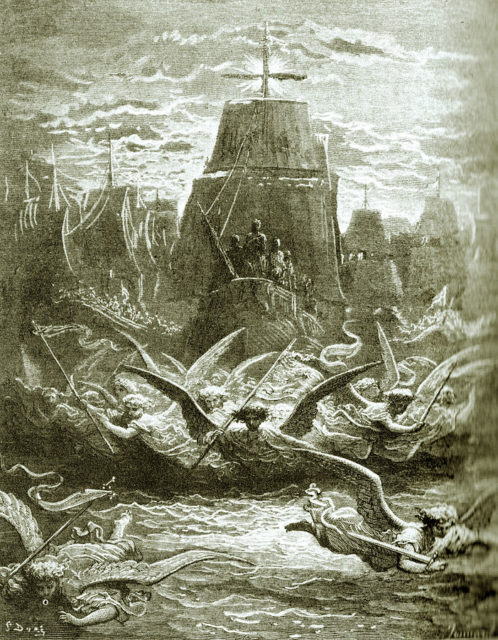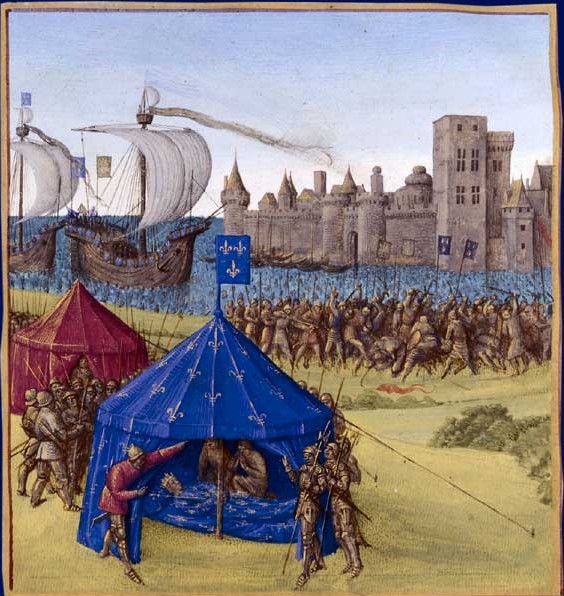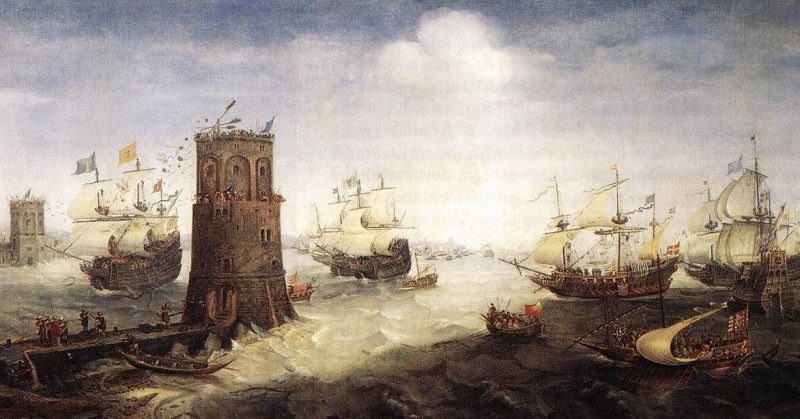The word “crusade” normally evokes images of war in the Middle East, with European crusaders fighting Muslim Arabs. But crusades took place all over Europe and the Mediterranean, anywhere Christian Europeans found themselves in conflict with heretics or outsiders of other religions. The strategic importance of Egypt, once the grain basket of Rome and now on routes into the Holy Land, led many crusaders to turn their eyes towards Africa.
The Fifth Crusade
The Fifth Crusade was a disorderly affair, lacking a clear leader at the head. Starting in Syria in 1217, it proved ineffective there. The crusaders, including Austrians, Hungarians, and knights who had settled in Jerusalem, sailed south in hopes of taking Egypt instead.
The crusaders’ goal was Cairo, but before advancing there they needed to take Damietta, to give them a base on the coast. They spent much of 1218 and 1219 besieging the town, using artillery bombardments, assaults from bridges, and even a siege tower built on two ships bound together to attack from the sea.
The winter of 1218-19 saw the besiegers ravaged by storms and scurvy. The Egyptian commander in the region, al-Kamil, launched counter-attacks in an attempt to relieve the siege. In August 1219, the Muslims feigned a retreat in the face of an attack, drawing the disorderly crusaders out into the desert and then forcing them into a retreat.
But the siege remained in place, even after a final attack by al-Kamil in November. On November 5th, 1219, Damietta fell to a crusader assault. Inside, they found the defenders mostly dead or dying from starvation.
For the next year, the crusaders consolidated their position and waited for reinforcements, many of whom never came.
In July 1221 they advanced down the Nile towards Cairo, taking 1,200 knights, 4,000 archers, and support from 630 ships. Things looked bad for the locals, and al-Kamil sought peace terms.
Just as success seemed within sight for the crusaders, disaster struck. Trapped between the rising water of two branches of the Nile, they were surrounded when al-Kamil sank ships to block the Nile. As more Muslim forces circled in from the north-east, the crusaders tried to retreat but were unable to escape. They surrendered on August 29th and handed over Damietta in return for their freedom.

St Louis’s Crusade
When King Louis IX of France set sail for Egypt in August 1248, his was a better-organised expedition. Financed by the richest country in Europe, centrally led and well planned, it crossed the Mediterranean in a fleet of the finest modern ships. Wintering in Cyprus, Louis turned the island into a massive forward supply base.
Arriving at Damietta on June 4th, 1249, Louis laid siege to the town with his 2,500 knights and 10,000-12,000 infantry. Within two days he achieved what took the previous crusade a year and a half, and Damietta fell.
Unlike his predecessors, Louis took the Nile floods into account. He waited for them to subside and for reinforcements led by his brother to arrive. Then, in October, he set out down the Nile.

Arriving near Mansurah, Louis found Muslim forces blocking his way across a canal to the town. He had his engineers try to build a causeway across, but the defenders dug out the far side ahead of them and bombarded the crusaders with Greek fire, causing horrible deaths and injuries. On February 8th, 1250, a crusader attack made it across the canal via a pontoon bridge. But discipline broke down, crusaders led by Robert of Artois charged ahead into the town and were massacred, and the attack was halted.
On 28 February, Egyptian reinforcements arrived under the Sultan Turanshah. They cut off the crusaders’ supply route, capturing 80 of their supply ships before Louis gave up and called a retreat.
By now, many of the crusaders were sick with typhus and dysentery. The sick and wounded were loaded into galleys to sail back up the Nile, but were captured and most of them put to death. Louis led the rest of his forces north overland but was also cut off and forced to surrender. Once again, Damietta was returned to its owners in exchange for the release of the crusading force.
The Tunis Crusade
The 1260s saw Christian territory in the Holy Land falling to relentless pressure from Muslim commanders. Jaffa, Arsuf, Caesarea and Antioch all fell. The apparently unbeatable Templar castle at Safad fell after a siege of only 18 days. The crusader states were in tatters, and help was desperately needed. Once again, the wealthy French were called upon for support, and once again, King Louis IX led the response.
After his failure in 1250, Louis had spent four years building coastal defences in the Holy Land and established a 100-strong French Regiment of knights there. It was, therefore, natural to expect that he would leap to the defence of that territory, and many assumed that was where his crusade was heading when he set out in 1270.
Instead, Louis launched an attack on Tunis, much further to the west. This could theoretically be justified as part of a wider anti-Islamic strategy, but really it was about supporting his brother, Charles of Anjou, who had recently seized control of nearby Sicily.

This was the most disastrous crusade into Africa yet. In the July heat, disease spread like wildfire through the French camp. Louis fell sick and died on August 25th. His heir became King Philip III and took responsibility for making peace and withdrawing the army. Some troops from the expedition, including Prince Edward of England, sailed on to Acre and fought for the Holy Land, briefly holding back the tide.
By the end of the 14th century, the crusader states would be all but wiped out. All Louis had achieved was his own untimely death.
